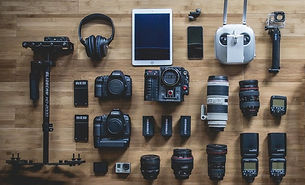Why take photos?

Controlling the Camera
So far we have learned about the basic settings on a camera (ISO, shutter speed, and aperture). In this section of the course, we spend more time with a camera in hand, using some new techniques and taking advantage of the available settings we have learned about. We will also start to consider compositional techniques and methods to plan, and mindfully approach photography.
Topics of Study
-
depth of field and aperture
-
white balance
-
Bokeh
-
E/V compensation
-
EXIF information
-
RAW and other formats
-
frame, focus and shoot
-
shooting in manual mode
-
planning your image
4.1
UNIT: CONTROLLING THE CAMERA
DEPTH OF FIELD

Depth of Field
Using the aperture settings, we learn to create narrow and wide depth of field in our photos, a tool used by photographers to aid in focusing the viewer’s attention on the desired subject.
4.2
WHITE BALANCE

White Balance
You have probably heard of warm and cool light, but what does that mean, and how does it affect our photography? Understanding how light works and how the camera sees light and colour, helps us tell the camera what to expect in different conditions.
4.3

Bokeh
Use your knowledge of Depth of Field to manipulate your scene and create Bokeh, a Japanese word describing the quality of soft, unfocused light circles.
4.4
UNIT: CONTROLLING THE CAMERA
EXPOSURE CONTROLS

Exposure Controls
As you get more comfortable with the camera and the settings, you can start to take creative control by better understanding how the camera makes its decisions and where you might have to take back some of the decision making.
4.5
UNIT: CONTROLLING THE CAMERA
AUTOFOCUS AND METERING

Autofocus and Metering
A number of settings on your dSLR camera help it capture the exact image you are hoping for. Because the camera can only guess at the subject of your photo and what is most important, we use some of the camera’s features to ensure the camera is making the right choices when we press the shutter release.
A4.6

Levitation 2
Let's see how far you've come. Your first photography assignment in this course was Levitation. Now that you have some practice with the camera, understand composition, know how to scout a location, have experience with shutter speed and are an all-round better photographer, DJ, drop the remix.
A4.7

Multiplicty
Double exposure and even multiple exposures are not new techniques, but they are quite effective methods of quickly create artistic interest, a story or a visual connection between ideas. In this lesson we will explore methods of manipulating images to create an engaging multiple exposure photograph
CT4.8
COMPLETION TASK: 4.8
EVOLUTION OF AN IMAGE

Evolution of an Image
Read the article and apply the principle of critically analyzing and improving your own work to a photo taken and selected by you
4.9
QUIZ & SKILLS TEST

Assessment
The assessment for this unit includes both a quiz covering unit 4, and a skills test requiring you to perform a selection of tasks